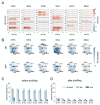Granger Causality Analysis of Transient Calcium Dynamics in the Honey Bee Antennal Lobe Network
- PMID: 37367355
- PMCID: PMC10299490
- DOI: 10.3390/insects14060539
Granger Causality Analysis of Transient Calcium Dynamics in the Honey Bee Antennal Lobe Network
Abstract
Odorant processing presents multiple parallels across animal species, and insects became relevant models for the study of olfactory coding because of the tractability of the underlying neural circuits. Within the insect brain, odorants are received by olfactory sensory neurons and processed by the antennal lobe network. Such a network comprises multiple nodes, named glomeruli, that receive sensory information and are interconnected by local interneurons participating in shaping the neural representation of an odorant. The study of functional connectivity between the nodes of a sensory network in vivo is a challenging task that requires simultaneous recording from multiple nodes at high temporal resolutions. Here, we followed the calcium dynamics of antennal lobe glomeruli and applied Granger causality analysis to assess the functional connectivity among network nodes in the presence and absence of an odorous stimulus. This approach revealed the existence of causal connectivity links between antennal lobe glomeruli in the absence of olfactory stimulation, while at odor arrival, the connectivity network's density increased and became stimulus-specific. Thus, such an analytical approach may provide a new tool for the investigation of neural network plasticity in vivo.
Keywords: Granger causality; antennal lobe; calcium imaging; olfaction; sensory network; two-photon microscopy.
Conflict of interest statement
The authors declare no conflict of interest.
Figures



References
Grants and funding
LinkOut - more resources
Full Text Sources

